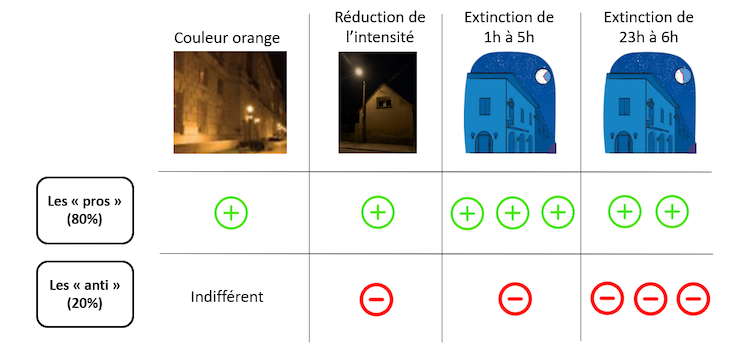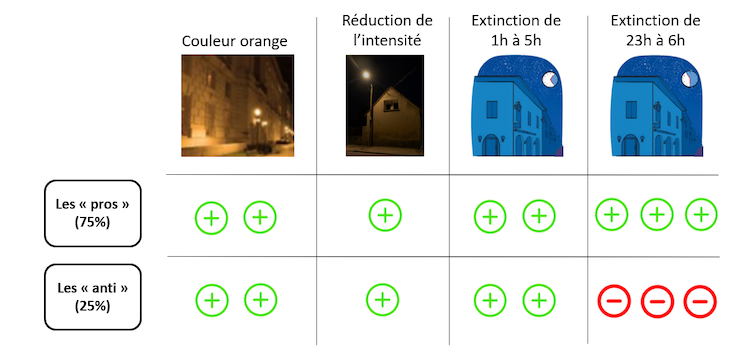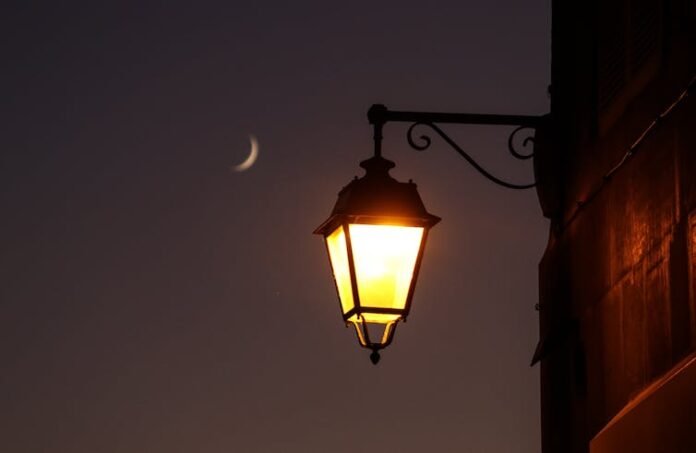Many French municipalities have taken measures to reduce public lighting as part of their energy sobriety plan. Ruben Christen/Unsplash, CC BY-NC-SA
Artificial lighting, public and private, has increased in recent years, in line with increasing urbanization. In addition to contributing to the collective energy bill, artificial night lighting generates light pollution, which affects plant and animal biodiversity, human health and complicates astronomical observations. However, nocturnal landscapes are part of the nation’s shared heritage, as set out in the Environment Act.

Cloud background brightness in the Hérault department and Montpellier Metropolis, located not far from the emblematic Cévennes National Park, which has been awarded the prestigious label International Dark Sky Reserve since 2018. Cloud background brightness is a proxy for light pollution, expressed in size per second of arc2 (mag/arcsec2), which corresponds to the brightness of stars perceived from the earth (source La Telescop and DarkSkyLab). The telescope and DarkSkyLab, Provided by the author
In order to combat light pollution and initiate their ecological transformation, the municipalities have several options, which the current energy situation forces them to consider more and more through energy sobriety plans.
They can e.g. adapt their lighting system or their lighting methods by completely or partially turning off the light, changing the type of lamp, improving the orientation of the street lights, etc. (see the recommendations in the “Black Frame” guide produced by the French Biodiversity Office).
But what do the people directly affected by these changes think?
In order to assess people’s sensitivity to changes in public lighting, Inrae conducted a study based on a “choice experiment”, aimed at the inhabitants of the Montpellier Méditerranée metropolitan area, and extended to the rest of France to have elements of comparison.
Three ways to reduce light pollution generated by public lighting
Our research team’s consultation with lighting professionals, community representatives and experts from the Green and Blue Grid Resource Center helped identify three realistic, pollution-reducing dimming modes of light and its impact on biodiversity: the decrease in light intensity, the switching off of lighting at different times of the night and the change of the color of the light, orange-yellow lights have less influence than white light that emits in the blue (especially LED lamps) on biodiversity.
The variation of the housing tax (or other equivalent local tax) has been integrated to allow individuals to take into account the economic impact in their choice of preferences for a lighting profile.

Example of a choice card between two options with a change in lighting regime (situation 1 and situation 2), and an option without a change in lighting (reference situation). Nine choice cards, designed according to an effective experimental design, were presented to the individuals and illustrated different options. For each election card, people had to vote for one option among the three offered. The choices are then processed statistically to get out the major trends that explain the variations in the choices. The survey was conducted during the summer of 2021, in the Métropole de Montpellier (1148 responses) and in the rest of France (555 responses, mainly from the metropolis of Bordeaux and Greater Paris). AuthorsCC BY-NC
Citizens more favorable than others
The results of the sample of the Montpellier Méditerranée metropolitan area show that citizens, regardless of their socio-economic characteristics and their place of residence, are on average in favor of a change in public lighting, but not necessarily in accordance with the proposed methods.
Regarding the latter, a strong polarization of preferences is observed: 80% of the people who responded to the survey comply with the lighting changes (“the pros”) and 20% are reluctant about them (“the antis”).
More precisely, the former are favorable for a reduction in the intensity of the light and a color change from white to orange, very favorable for a switch-off from 1h to 5h and to a lesser extent favorable for a shutdown from until They report that they are more often sensitive to the environment and bothered by intruding light.
“Anti”, on the other hand, is not in favor of a decrease in the intensity of the light, indifferent to a color change from white to orange, slightly against a switch-off from 1h to 5h and strongly against a shutdown from 23.00 to 06.00. This group is characterized by a greater use of public space at night, to go out or work at night, and by a population that more often feels that they live in neighborhoods where turning off the lights can cause security problems.

Preferences of the two classes of individuals for the characteristics of lighting in the metropolis of Montpellier Méditerranée. A statistical model (with “latent classes”) showed that these two classes emerge in the choice of lighting profiles. Authors
It is in the municipalities with medium density (corresponding to the peri-urban municipalities in the metropolis of Montpellier) that the population studied is the most favorable for extinguishing from 23.00 to 06.00.
This can be explained by limited access to public transport in this type of municipality and thus more frequent car use. Consequently, the feeling of potential nocturnal insecurity is less there than in more urban areas, where residents travel more often on foot.
The feeling of uncertainty, a big obstacle
Statistics from the survey results showed that older respondents, women and people who walk are less likely to support a major change in street lighting. This is explained in the sample by a stronger feeling of insecurity for these categories of the population.
This view particularly hinders the adoption of a measure to turn off the lights from 23.00 to 06.00. In the questionnaire, the reservations mentioned by the respondents regarding the regulation of the lighting are the reduced sense of security, even the fear of increased crime (assaults and burglaries) and the risk of traffic accidents.
Other arguments were mentioned to a lesser extent, such as reduced visibility and fear of falling or the cost of public order.
Very few studies provide information on the safety implications of changing the lighting, and especially switching off. A recently published article suggests that turning off and dimming the lights has no effect on the frequency of burglaries, armed robberies or physical violence. There is even a decrease in car thefts in the extinguishing areas, but an increase in the adjacent streets where the lighting remains unchanged, suggesting a spatial shift in crime.
Energy savings, the main driving force
However, the vast majority of respondents are in favor of adapting the lighting to reduce light pollution. The main driving forces behind this acceptance are primarily energy savings and then the preservation of biodiversity. The effects on health and on the observation of the sky seem to be more secondary positive consequences.

For what reasons are you in favor of changing the lighting?
Similar results in the rest of France
At the French level, the same polarization of preferences is observed in two classes, where “anti” is, however, slightly more numerous than in the metropolitan area of Montpellier (25% in France against 20% in the metropolitan area of Montpellier). The latter, however, is less reticent about the various changes (and is even in favor of them), but remains strongly against the extinction of the light from 23.00 to 06.00.

Preferences of the two classes of individuals for lighting characteristics (France). Authors
Furthermore, differences in socioeconomic factors that explain class membership also occur. For example, contrary to what has been observed in the metropolitan area of Montpellier, it appears that the elderly in the French sample are more likely to accept a change in public lighting than the younger. Probably explanation, these people move less at night and are therefore less affected by such a change. Some factors are similar, men are still more likely to favor a change in public lighting.
Lessons for communities
The results from this quantitative study (through an election experiment) confirm the results from the qualitative study carried out in the metropolitan city of Lille, especially on the fact that individuals are generally positive or very favorable towards a change in public lighting.
Changing the color of the light from white/blue to orange seems to be a measure that is easily acceptable to the population, while at the same time having strong consequences for biodiversity. To switch off from 01.00 to 05.00 or reducing the light intensity also seem to be easily adopted measures, especially in residential areas, without having to fear too much opposition from the residents.
Resentment, even resistance, focuses on the extinctions from 23.00 to 06.00, indicating that this measure must be subject to prior consultation and address municipalities where acceptance is likely to be the most important, such as in suburban municipalities. In particular, consultation may aim to define the times of extinction and ignition that are most acceptable to the population.
The statistical study of the answers to the questionnaire also highlights that informing the population about the harmful effects of light pollution, especially on biodiversity and energy consumption, is a lever that promotes the acceptance of changes in lighting among the population.
Finally, she emphasizes that people living in cities that have already implemented measures to reduce light pollution are more likely to accept more ambitious progress (such as switching off from 11pm to 6am). A gradual introduction of changes in time and space would therefore be preferable in order to increase the population’s adherence to the lighting regulations in order to reduce light pollution.
This article is republished from The Conversation under a Creative Commons license. Read the original article.
